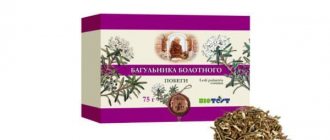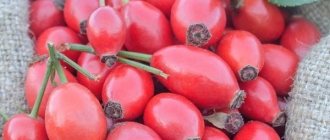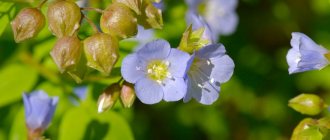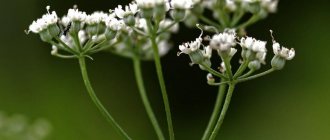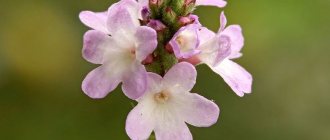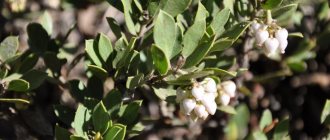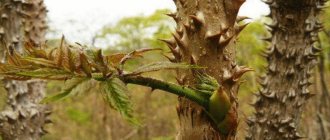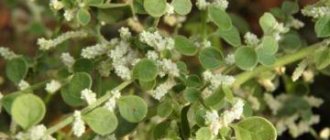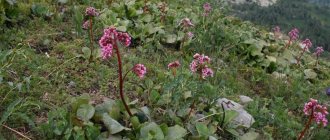This plant prefers hilly areas or wastelands, and grows especially readily on cliffs above rivers, where there is a lot of water. The leaves or flowers of coltsfoot are mainly used as medicine; they are often used as a collection in combination with other plants. For example, to combat cough, coltsfoot is combined with plantain or raspberries.
This plant got its amazing name because of its very specific temperature. Its leaves are bright green on one side and covered with a large amount of white fibers underneath. If you touch the green side of a leaf, you will feel that it is cool, regardless of the temperature around you. At the same time, the underside with fibers is very warm, and it is because of this that the plant received its unusual name.
Introduction
The choice of recipes for various coltsfoot remedies is quite large. Typically, they are used as a side therapy for colds, however, their use is not limited to this. Among different peoples living in the habitat of this species, its use could sometimes differ significantly.
Coltsfoot during flowering
In addition to its medicinal properties, coltsfoot is one of the most popular honey plants . The honey obtained from it has good taste characteristics. Just like a honey plant, coltsfoot has significant advantages.
Firstly, it produces an acceptable yield of both nectar and pollen, and secondly, due to its unpretentiousness, it can occupy large areas, that is, ensure mass collection.
Reproduction
Coltsfoot can infest crops and often acts as a pioneer in colonizing empty areas, especially those with sandy soil.
This good distribution is due to the active reproduction of the plant. Coltsfoot can reproduce equally well vegetatively and by seeds. Each section of the rhizome, when broken off, grows back and produces a new individual.
Propagation by seeds is also effective, since each plant produces more than five thousand seeds. Carried by the wind, they germinate in moist soil within the first day.
Biological description
From a botany point of view, coltsfoot is a perennial herbaceous shrub , which is a monotypic representative of the Astrov family. This means that this species is unique in the entire family. Indeed, the structure of the plant is such that it is unlike any other.
The flowering part of the coltsfoot has a large number of small yellow flowers collected in inflorescences-baskets. A peculiarity of the plant is that its flowering occurs in early spring, and it occurs before the leaves appear.
Coltsfoot leaves on both sides
But the unique properties of this herb do not end there. Its leaves have completely different structures, which even leads to the appearance of different microclimate conditions in different parts of the leaf. The underside of the coltsfoot leaf is covered with many small hairs.
This leads to the fact that the evaporation of liquid from the lower surface of the sheet occurs very slowly, one might say, does not occur at all. At the same time, as with a smooth upper surface, especially one exposed to sunlight, evaporation occurs at a much faster rate.
Evaporating moisture causes significant cooling of the upper part of the sheet, while the lower part remains relatively warm. Sometimes the temperature gradient between the upper and lower parts of the coltsfoot leaf can reach 3°C. The lower side, which is warmer, is popularly called “mother”, and the upper, colder side is called “stepmother”.
Flowers along with the leaves that have already appeared
However, this plant also has other names. Among them you can find the following:
- one-sided
- camouflage grass
- double leaf
Moreover, sometimes coltsfoot under these names will be found in completely official sources. Translated from Latin, the official name of coltsfoot means “herb that expels coughs.”
The plant is very widespread in Eurasia. From the shores of the Atlantic Ocean to Western Siberia, it can be found at any latitude - from the Mediterranean Sea to Murmansk. However, the range of the coltsfoot, although it has a fairly large area, is not continuous.
For example, in Ukraine it is not found throughout the Dnieper Lowland, although it is found in almost the entire rest of the territory. A similar picture is observed in Scandinavia, and in Eastern Europe, and in the Middle Zone, and in the Urals. Scientists cannot yet provide an explanation for such a “spotted habitat” of a monotypic plant.
In addition, coltsfoot has a certain selectivity to soil types. For example, it is almost always found in areas where there is no turf or turf soil.
For coltsfoot there is nothing better than the various slopes of ravines or steep river banks. There are frequent cases of the plant appearing in places of intense human activity - wastelands, landfills, agricultural lands, even landfills and abandoned industries.
Wild field of coltsfoot
The plant's dislike for turf soil implies that clay soils are more preferable for the plant. And this is so: coltsfoot grows best on clay soils.
However, if the seeds of a plant find themselves in more or less favorable conditions, even on “inconvenient” sandy soils, it will be able to grow to a huge colony due to its unpretentiousness.
The plant blooms in mid-April, and after about a month its first leaves appear. The plant has a very powerful root system. The root of the plant is long and branched. The top of the root is dotted with many buds. In spring, two types of shoots are formed from them. First - shoots of peduncles, later - shoots of leaves.
Generative stems of a plant
Moreover, this does not mean that the flowers are devoid of leaves at all. Flowering or generative shoots are covered with small ovoid leaves along their entire length. They are brown in color and sometimes look very scale-like.
The coltsfoot flower is very complex in structure and consists of many small flowers of the female and bisexual types, collected in two rings relative to the center. In total, the inflorescence can contain several hundred small flowers.
Flower close up
The fruits of coltsfoot are achenes with parachutes, that is, they are very similar to the fruits of an ordinary dandelion . After the fruits are ripe, the generative shoots die off, they dry out, and around this time the seeds are dropped from the dried peduncle.
Fruits of the plant
The medicinal use of the plant is due to the set of chemical components that make up the leaves . The leaves of the plant can be up to 20 cm in diameter. They have long, hard petioles and serrated edges. Usually the number of leaves and flowers on a bush is approximately the same.
Plant leaf ready for harvest
The leaves are collected in the spring, when the concentration of essential medicinal substances in the plant is maximum . Typically, this occurs when the veins on the leaf become reddish-brown.
Botanical description
Coltsfoot is a plant with a long root.
In early spring, stems 10 to 30 cm high grow from the root, which are dotted with leaves with brown-red scales. At the end of the stem there are baskets of numerous yellow flowers: the marginal flowers are narrow-ligulate, female, the middle tubular ones are bisexual. The fruits of the plant are small achenes with a tuft of rough bristles. After the fruits ripen, the flowering shoots die off. It blooms in April - May. After fruiting, basal leaves grow from the rhizomes on long petioles, with notched-toothed edges. The top of the leaves is green, and the bottom, due to the thick “felt” pubescence, is white
The plant is found in Eurasia, Africa, North America. It grows everywhere in Russia. For growth and reproduction, it selects the banks of rivers and streams with sandy soil, ravines and clay cliffs
Growing a plant
Despite the fact that leaves for medical purposes are mostly collected in the wild, sometimes there are enthusiasts who grow coltsfoot in private.
Beekeepers also often grow this plant, since coltsfoot not only produces high-quality honey, but is also one of the earliest flowering honey plants. Traditionally, abandoned areas or vacant lots are used for these purposes, since the plant is quite unpretentious.
The plant can be propagated equally well by both seed and vegetative methods . Particularly popular is dividing the rhizome.
Due to the absence of any particular negative impact on the soil, as well as due to its good adaptability to almost any conditions, coltsfoot can grow for decades in the same place in the garden without replanting.
In this case, it may even be necessary to slightly limit the growth rate of the plant, since it reproduces extremely well and quickly covers large areas.
Bee on coltsfoot flowers
The plant feels best in partial shade, but can also grow in full sun. But the shadow doesn't really suit him.
It is believed that this plant does well without care , so no one has dealt with the issues of its cultivation, and, as a result, selection. Everyone is happy with its current state. However, the reaction of this herb to fertilizers is quite demonstrative, which makes it possible to achieve a high rate of reproduction in the first 1-2 years of cultivation.
Preference is given to organic fertilizers, which are recommended to be applied once a year at the end of autumn to the location of the plants. These can be: compost, humus or bird droppings diluted with water in a concentration of 1 to 20.
It is necessary to water the plant only in extremely hot weather , making sure that moisture does not get on the outer part of the leaves. Also, the plant does not need to loosen, hill up or mulch the soil. The existing opinion that the plant can only exist near open sources of water does not stand up to criticism - even bindweed or mallow will envy the drought resistance of coltsfoot.
Coltsfoot is often used as early flowering perennials for flower beds. And the high unpretentiousness of the plant allows them to be used in rock gardens and rockeries.
Plant in "deciduous phase" on rocky soil
Propagation by vegetative method is very simple - the daughter root is separated from the mother root in mid-spring and transplanted to a new location. Already at the end of the next season, a large colony of plants will form at the site of its planting, consisting of about a couple of dozen flowers and 2-3 daughter roots of the next generation.
In addition, do not be surprised if plants that look like coltsfoot, but are somewhat smaller, begin to hatch in all corners of the garden. This is the result of the plant self-seeding.
Small seedlings mature for about three years before they begin to bloom. At the beginning, they will form a powerful root system and a sufficient number of generative and vegetative buds will appear.
Toxicity and carcinogenicity of the plant
Japanese scientists studied the carcinogenic properties of coltsfoot. The results of experiments with rats were published in the Japanese Journal of Cancer. According to the observation conditions, all animals were divided into groups of 10 individuals:
- Group I - received a diet consisting of 32% coltsfoot for 4 days, then - until the end of the experiment - a 16% diet;
- Group II - animals received coltsfoot in the amount of 8% of the total diet for 600 days;
- Group III - diet with 6% coltsfoot of the total nutrition throughout the experiment;
- Group IV (control) - those following a regular diet without the addition of coltsfoot.
After 600 days, the experiment ended and the results were summed up:
- Animals of the first group lived more than 380 days after a 32% coltsfoot diet. Eight out of 10 rats were diagnosed with a rare form of liver cancer.
- Among the rats of the second group, a liver tumor was found in only one animal.
- In the third group, all animals were healthy, without signs of changes in the liver.
Based on these findings, scientists came to the conclusion that the main factor in the appearance of changes in the liver of rats was the intake of large amounts of pyrrolizidine alkaloid or senkirkine [10]. This chemical compound, toxic to the liver, is found in dried coltsfoot flowers.
The Journal of Applied Toxicology published the results of another coltsfoot study in 2010. In rats receiving herbal supplements with this herb, DNA structure transformations were detected, which are observed in the early stages of some forms of cancer [11].
During the same experiment, it turned out that oncological changes initially occur in the liver. Secondary foci of cancer were found in the kidneys, lung tissue, bladder, skin, adrenal glands, brain and skin.
There are no clear facts confirming that pyrrolizidine alkaloids provoke the formation of malignant tumors in humans. It has been established that the frequent consumption of coltsfoot tea by some indigenous African peoples is directly related to the frequent detection of liver tumors in them.
Molecular Medicine Reports published a study of several cases of fatal intoxication after ingestion of plants containing pyrrolizidine alkaloids, including coltsfoot [12].
A group of scientists has proven that coltsfoot, like other plants containing pyrrolizidine compounds, can have a toxic effect. As a result, patients are diagnosed with liver enlargement, liver failure or cirrhosis.
The conclusions of this experiment indicate that the coltsfoot can:
- cause genetic changes;
- provoke a mutation of the genetic code;
- have a detrimental effect on the intrauterine development of the child;
- cause malignant tissue degeneration.
Before starting treatment with pharmaceutical drugs or coltsfoot products prepared on your own, it is important to discuss this step with your doctor. Only a specialist can assess all possible risks and recommend the optimal dose of the drug. To avoid the development of negative complications, it is not recommended to consume coltsfoot for more than 6 weeks throughout the year.
Collection, preparation and storage of leaves
It is believed that not only the leaves, but also the flowers of the plant have medicinal properties. Flowers are collected already in early May, and the time for collecting leaves may vary depending on weather conditions.
The collection of leaves can be extended over a fairly significant period of time - from early May to mid-July . At the same time, the concentration of medicinal substances in the plant remains maximum until the beginning of August.
Harvesting leaves
The leaves are collected in sunny weather . The leaf is cut from the rosette along with a petiole about 4-5 cm long. If collection is carried out in the wild, plants growing near roadways or man-made buildings should be avoided. It is best to move somewhere far away from such objects; modern herbalists recommend distances of at least a kilometer.
Picking flowers
The leaves must be dried before use . This is done under a canopy, in the attic or in a ventilated room. The main requirement for drying is the absence of precipitation and high humidity.
The leaves are laid on a flat surface in one layer and turned over to the opposite side once a day. This procedure helps to avoid bedsores and rotting. Dried leaves need to be crushed a little - this will provide more comfortable and convenient storage.
Flowers during drying
An alternative is to use special dryers with a temperature of about 40-50°C when drying leaves. With their help, you can reduce the drying process to 1-2 days.
Dried components must be stored in fabric bags or cardboard boxes. Hermetically sealed storage in glass jars is not excluded. In this case, it is advisable to attach a label to each box, bag or container, indicating the place and time of its collection. The shelf life of coltsfoot in dried form is from 2 to 3 years.
Possible side effects
Of course, the use of coltsfoot can have a beneficial effect on the body and help in the treatment of a number of diseases, but we must not forget about the likelihood of negative symptoms.
The plant contains pyrrolizidine alkaloids. Their effects on the body with prolonged internal use can provoke acute or chronic liver damage [7]. Scientists have published reports of cases where taking coltsfoot supplements and herbal remedies led to serious consequences and even death.
It is known that one of the participants in the experiment took tea from coltsfoot flowers throughout her pregnancy. A seemingly harmless drink led to blockage of the newborn’s hepatic blood vessels and his death [8].
A case of blood clot formation in the lung of a man was described following long-term use of herbal supplements with coltsfoot and several other herbs [9].
Possible side effects include:
- internal bleeding;
- nausea;
- diarrhea;
- pain in the abdomen;
- increase in body temperature.
The healing properties of coltsfoot
Coltsfoot leaves contain the following components:
- glycosides
- tannin
- sterols
- carotenides
- tannins
The leaves also contain vitamin C, its concentration is 250 mg per 100 g of raw product.
Crushed dried coltsfoot leaves
The pharmacological effect of the plant lies mainly in a pronounced expectorant effect , which is a consequence of the large number of mucus components contained in its leaves.
Making an infusion of flowers
In the lower respiratory tract, in addition to expectoration, coltsfoot also restores the normal activity of the ciliated epithelium of the bronchi and trachea. In addition, it has a mild anti-inflammatory, antispasmodic and diaphoretic effect.
Interesting Facts
- By the colors of the coltsfoot, you can accurately predict the upcoming change in weather during the daytime. If the next few hours are warm and sunny, the flowers will open, and if the weather turns bad and it starts to rain, they will close in advance
- In the old days, according to the places where coltsfoot was concentrated, they determined the place in which it was necessary to dig a well, since the plant loves moisture and independently determines places with the presence and shallow occurrence of aquifers
- The name “coltsfoot” is due to the fact that its leaves are smooth and cold on top, and soft and warm below, like felt. Accordingly, their lower surface is associated with the mother, and the upper surface with the stepmother.
- Almost all plants first grow stems and leaves, and then flowering begins. With coltsfoot everything is exactly the opposite - in the spring, when the first snow melts, first the flowers grow and bloom, and only then the leaves grow
Photo gallery
Application area
Soap from coltsfoot
The use of coltsfoot is indicated as maintenance therapy for a number of diseases of various body systems:
1 For pathological processes in the upper respiratory tract. Traditionally, the effect of coltsfoot is used as an anti-inflammatory and facilitating sputum discharge. In addition, due to the mucus components contained in the plant preparations, inflamed surfaces are enveloped and softened. Herbal infusions are used for throat diseases - sore throats and tonsillitis, as well as other diseases of the respiratory organs - pleurisy, laryngitis, pneumonia, etc. For non-disseminated forms of pulmonary tuberculosis, tinctures from the leaves are recommended for use at the final stage of a course of antibiotics.
2 In case of damage to the digestive organs . Since infusions and decoctions of the plant have anti-inflammatory and antispasmodic effects, they can help in the treatment of gastritis, ulcers, pancreatitis and cholecystitis. Sometimes an infusion of coltsfoot is recommended for problems with the functioning of the liver and gall bladder.
3 Various infections of the genitourinary system . These include cystitis, pyelonephritis, etc.
4 For children over two years old, coltsfoot also helps cope with diathesis and other manifestations of allergic reactions. In this case, you can use powder from crushed leaves for external application on the affected area, or use the herb infusion orally.
5 Very often the plant is used for various inflammations of the mucous membranes of the oral cavity. This also includes numerous dental diseases. Rinsing the mouth for stomatitis, dental diseases, gingivitis, etc. not only relieves inflammation and disinfects, but can also somewhat reduce pain.
6 It is believed that coltsfoot leaves also have the ability to normalize blood pressure, that is, they are a hypotonic agent . Some researchers are convinced that the substances contained in coltsfoot can significantly slow down the formation of atherosclerotic plaques in blood vessels. Infusions of leaves are recommended to be used not only for atherosclerosis, but also for heart failure and other diseases of the cardiovascular system.
7 Using a decoction of the leaves helps in the treatment of mastitis , however, the plant is not recommended for use during breastfeeding.
8 Healing effect . When used externally, a decoction of coltsfoot helps fight the effects of purulent infections, the effects of acne, and furunculosis. It has a good healing effect on burns, abrasions, small and medium-depth wounds, and various scratches. Usually, cotton swabs moistened with a decoction are applied to the affected areas. In some cases, freshly picked leaves are applied to wounds, such as plantain.
9 Cosmetologists and trichologists recommend using the plant in the form of an infusion when washing your hair or rinsing your hair . The infusion helps strengthen the hair roots, relieves inflammation around the hair follicles, and relieves dandruff from the scalp.
10 Therapy is limited not only to the listed methods of using the plant . Often, infusions and decoctions of coltsfoot are recommended as a general tonic for people with decreased immunity or loss of strength. A decoction of these leaves is also included in many preventive measures.
11 The plant is often included in weight loss products - mainly as an auxiliary component of various teas or infusions.
Methods of use at home
Water burdock is used at home in different forms: baths, applications, compresses or inhalations for various respiratory diseases. To do this, you do not always need to boil the mixture. You need to collect the leaves of the plant during flowering, when the grass contains a large amount of useful substances. The following describes home remedies.
Applications
Applications from the plant are used for polyarthritis, rheumatism, furunculosis, ulcerative lesions, infected wounds, scrofulous ulcers, calluses. To use coltsfoot, you need to collect fresh leaves of the plant, knead, and squeeze. The mixture is spread on the affected area, wrapped in parchment paper, and secured with a bandage. Sometimes you can brew dry leaves with boiling water, cool, and apply to sore spots.
Inhalations for respiratory diseases
During colds, inhalations based on chamomile and water burdock are used. Take a teaspoon of herbs and 2 teaspoons of chamomile. Then pour 0.5 ml of boiling water, boil over medium heat, cool to a warm state. Next, bend over the pan, cover your head with a towel, and inhale the steam for 7-10 minutes. At the same time, not only cold symptoms disappear, but also acne and acne.
Foot baths
Foot baths not only help to cope with fatigue and tingling feet. The plant can help with varicose veins in the legs. Baths can be taken several times a week. The duration of the procedure is about 25 minutes. To prepare a bath, pour boiling water over two full handfuls of leaves and leave for a little while. Then the infusion is poured into a bowl of hot water.
Leaf compress during lactation
During lactation, a woman’s body decides when breast milk collections are required and in what quantities. In order to reduce the appearance of milk, facilitate this process, and prevent the appearance of hardening and other pathologies of the breast, it is necessary to apply compresses directly to the breast. To do this, take washed water burdock leaves and apply them with the shiny side on your chest. Coltsfoot - its medicinal properties and contraindications, is used very often for these problems or possible diseases.
Medicines
Tea made from crushed leaves
Infusion
Dried coltsfoot flowers
- This remedy is obtained from one tablespoon of finely crushed coltsfoot leaves, poured with 200 ml of water, brought to a boil . Next, you need to boil the infusion for 15 minutes and leave it to infuse.
- Infusion time is about 1-1.5 hours. After which, without waiting for the infusion to cool, it must be strained through a fine sieve. In this case, about 5-10% of the liquid volume is lost. It is necessary to add boiling water to the infusion to 200 ml and leave it to cool.
- This remedy is used 2 to 4 times a day in doses of 50 ml at a time.
- An infusion of leaves is mainly used to treat colds . And an infusion of flowers is used in the treatment of diseases of the gastrointestinal tract, as well as diseases of the cardiovascular system.
Decoction
Decoctions are mainly used in the treatment of gastritis
The recipe for its preparation repeats the previously discussed infusion, but two tablespoons of leaves are taken, that is, the concentration is doubled.
Leaf juice
Juice from coltsfoot leaves
- Sometimes the plant is used not only in dried form . In some cases, it is possible to use it directly from the garden. At the beginning of summer, coltsfoot leaves are collected. They are crushed on site and the juice is squeezed out. Juice can be squeezed out using any means - from manual juicers to semi-industrial automatic juicers.
- The juice will be stored in the refrigerator for several weeks . Before use, it is diluted with water in a ratio of 1 to 1 and brought to a boil. Boil for a minimum of 5 minutes. Used naturally or as part of tea. Taking more than 30 ml of juice at one time is not recommended.
- Juice and tea from coltsfoot leaves are good tonics . They can improve a person’s well-being, give him vigor and relieve fatigue. However, such a remedy is not recommended for continuous use for more than 3 weeks.
Recipes for medicinal preparations
Currently, there are about a dozen fees that include coltsfoot
Some of them can be purchased at pharmacy points of sale, however, if you have the desire and opportunity, you can make such collections yourself.
Let's look at their recipes:
Collection used for acute forms of bronchitis Components:
- dried leaves of coltsfoot or its flowers – 20 g
- Alteyka root part – 40 g
- licorice root part – 20 g
- flower part of mullein – 10 g
- fennel (fruit) – 10 g
Application:
One heaping tablespoon of the mixture is poured into 500 ml of boiled water cooled to room temperature. After which it is infused for two hours in a cool, shaded place. After infusion, the mixture is brought to a boil and filtered.
It is recommended to consume warm (not higher than +40°C) several times a day. A single dose of use is 1 tablespoon.
Expectorant collection for colds Ingredients:
- dried coltsfoot leaves – 5 g
- flower part of mullein – 5 g
- flower part of mallow – 10 g
- thyme stems and leaves – 10 g
- anise fruits – 10 g
- Alteyka root part – 10 g
- licorice root part – 30 g
Application:
One tablespoon of the mixture is soaked in cold water for two hours and boiled in the same way as the previous collection. Use several times a day as needed, but not more than 500 ml per day to avoid allergic reactions.
Preventive collection for colds The following components are mixed in equal proportions:
- dried coltsfoot leaves
- linden flowers
- willow bark
- anise
- raspberries
For 1.5 liters of mixture this amount is 10 g of each component.
Application:
A heaping tablespoon of the mixture requires 500 ml of boiling water. First, it is brewed, and then the mixture must be placed in a water bath for at least 10 minutes. The decoction is filtered and consumed as tea. It can be stored in a thermos and consumed throughout the day.
Infusion of coltsfoot, linden and other herbs
Collection for diseases of the bladder and kidneys Components:
- dried leaves of the plant – 10 g
- Alteyka root part – 10 g
- dried oregano – 5 g
After mixing, the mixture must be crushed very well. A tablespoon of the resulting mixture is brewed with 400 ml of boiling water and left for no more than 15 minutes. After which it is filtered and consumed 6 times a day with equal intervals between them. The dose is 40-70 ml per dose.
Preventive agents for gastrointestinal diseases High concentration product: 15 g of dried leaves are crushed and 250 ml of boiling water is poured. In this form, the broth is left to cool on its own. After which it is filtered and drunk throughout the day in equal doses of 30-350 ml.
Low concentration agent. Recommended for kidney diseases. 20 g of dried leaves are infused in one liter of boiling water for 2-3 hours. Use warm 4 times in 50 ml doses.
Chemical composition
The medicinal properties of leaves (herbs) of coltsfoot are due to the content of the following substances in their composition: glycoside tussilarin, inulin, sitosterol, gallic, malic, tartaric and ascorbic acids, saponins, tannins and mucous substances, essential oil.
In addition, they contain the following macro- and microelements: potassium (37.70 mg/g), calcium (10.90 mg/g), iron (0.20 mg/g), bromine (107.10 μg/g ), boron (40.0 µg/g), selenium (25.00 µg/g), nickel (21.00 µg/g), silver (8.00 µg/g), copper (0.78 µg/g ), zinc (0.60 µg/g), molybdenum (0.40 µg/g), polonium (0.24 µg/g), cobalt (0.27 µg/g), etc.
Coltsfoot flowers contain: triterpenes (faradiol and arnidiol), tetraterpene taraxanthin, stigmasterol and sitosterol, carbohydrate heptacosane, tannins. Routine is also an important element.
Contraindications
Any drug has its limitations and contraindications.
The medicinal plant coltsfoot was no exception.
It cannot be used in the following cases:
- The use of the plant by children under 2 years of age is prohibited.
- Children under 14 years of age should use these drugs under close supervision and should stop taking the drugs if any negative symptoms occur. Symptoms include: rash, nausea, smell of acetone from the mouth, depressed state.
- It is strictly forbidden to use the drug during pregnancy or breastfeeding.
- The plant should not be used for severe forms of liver and kidney disease.
Despite the fact that almost all the medicinal properties of the plant have been studied, and their effectiveness has been well proven by practice, sometimes very unexpected phenomena occur.
Relatively recently, the unpleasant properties of pyrrolizidine alkaloids contained in coltsfoot were discovered. They are mainly found in flowers, but they are also present in leaves. In the body of living beings, when they are broken down, an intermediate chemically active compound can be formed that attacks liver proteins and damages their structure.
The mechanism of action of these alkaloids on the human body has not yet been sufficiently studied. Their toxicity and its consequences for the human body are currently difficult to assess. Therefore, doctors do not recommend using coltsfoot-based products for more than 1-1.5 months in a row.
Mother and stepmother in natural habitat
This approach means that pyrrolizidine alkaloids could theoretically accumulate in the liver. Therefore, after prolonged use of solutions and infusions from coltsfoot (and especially from its flowers), it is recommended to drink some, even the simplest course of hepatoprotectors. In the end, the liver is an unpaired organ; you shouldn’t risk it.
You should also always remember that the use of coltsfoot in treatment is an auxiliary therapy, and, no matter how wonderful this plant is, its use will not replace full treatment. Do not self-medicate, contact specialists!
VIDEO: Description, Healing properties
Legends about the plant
There are a large number of legends associated with the origin of the coltsfoot. Many of them are sad in nature and end in tears.
Thus, one of the most popular tells about a woman who lost her own daughter. After the death of a loved one, she sat for a long time in the cemetery, stroking the ground with her palms and caressing the place where the child was buried. Under the influence of maternal love, a colorful flower appeared from under the ground, covering the grave with its felt side with a warm surface. But besides her deceased daughter, the woman also had a stepdaughter, to whom she did not show such love. As a result, the underside of the leaves became hard and cold.
We recommend that you read St. John's wort in the treatment of pancreatitis
Another legend about the coltsfoot says that in the distant past a man left his wife and daughter and went to a new woman. But he constantly maintained a relationship with his beautiful daughter with luxurious golden hair, and his new wife did not like this very much. Inflamed with jealousy, she decided to kill the child and lured him to a cliff, and then pushed him down.
When her own mother realized and noticed that her daughter was gone, she ran in search and found her dead, thrown off a cliff. In order to take revenge on the evil stepmother, she also dragged her to this cliff, but in the struggle for life, both women fell down and died. At the site of their fight, small flowers with bright yellow inflorescences formed, reminiscent of the golden curls of the deceased girl. And the underside of the leaves symbolized maternal love, and the outer surface symbolized the hatred and cruelty of the stepmother. As a result, the plant became known as coltsfoot.
There is another legend, the heroes of which are members of a happy family, where the mother suddenly dies.
The distressed children stop playing and singing songs, and the father dries up from grief. But after some time, a young neighbor comes to the house and becomes the widower’s new wife. However, it was difficult for the children to get used to their stepmother, because... she will never be able to replace her mother, and her voice emanates coldness, and any touch is accompanied by anger and cruelty.
When the spring sun appeared outside, the youngest daughter ran with her sadness to the nearest river and began to cry bitterly, remembering her mother. And at one moment she raised her head, and a beautiful yellow flower grew near her feet. After this, the neighbor, who became the children’s stepmother, disappeared without a trace, and joyful laughter appeared in the house again. From that time on, the beautiful plant began to appear every spring, checking to see if the children were doing well, and then disappearing back. In summer, in its place there were lush leaves with a cold surface on top and a warm surface below.
Another legend of Ukrainian origin has an equally interesting plot. Once upon a time, a husband and wife lived for themselves, enjoying their love and the ringing laughter of their children. But one day the woman found herself in the pouring rain, got wet and fell ill. Every day she melted like a wax candle and could no longer rise on her own. Feeling upset, she called her husband to her and said to him: “Oh, Vasily, I will die soon. Take care of the kids, take a new wife, but not the neighbor's widow, because... She already has children and she won’t love ours.”
After the funeral, Vasily began to look for a new mother for his children. And it so happened that he wooed the neighbor’s widow. However, the predictions of the deceased wife came true: the stepmother divided the children into her own and her husband. The first received all the best, but the orphans starved, wore old clothes and were sick. When winter ended, the evil woman drove her husband’s children outside to warm themselves by the river bank. But the children were freezing in torn clothes and began to cry, asking:
-Sun! Warm our heads!
Looking at the poor children, the sun decided to warm them up by placing wreaths of golden flowers on their heads. Seeing what was happening, the stepmother decided to ask the orphans where they got these beautiful wreaths from. Having learned about what had happened, the envious woman immediately sent her own children to the river bank and said: “Take the blankets, let the sun give you wreaths.”
However, the heavenly body only burned the top of the blankets and hid behind the clouds. Soon a cold wind blew and froze the children, and flowers with yellow inflorescences and greenish leaves appeared on the shore.
Various customs and beliefs are associated with the coltsfoot plant. In the times of Ancient Rus', the grass had its own day - April 10. During this period, it was quite warm outside, and the snow completely left the ground. Then people came out of their houses and began to praise the grass.
The ancestors were of the opinion that after April 10, the flower loses its magical power and ceases to be beneficial to the body.
Wreaths of grass were woven on August 15 at Stepan's hayloft. On this day, people went out with their families, collected herbs and dried them.
